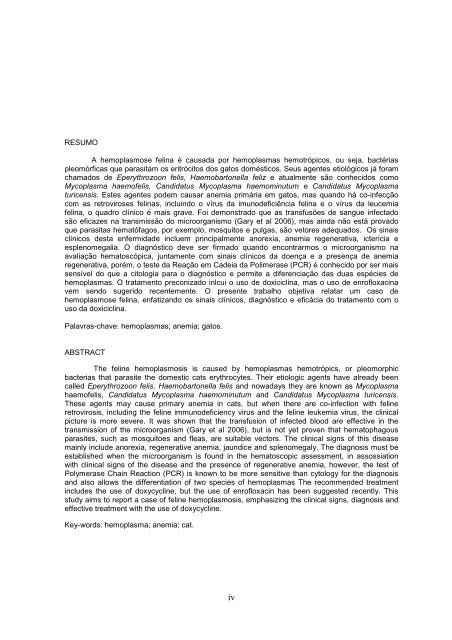Hemoplasmose felina - relato de caso - Adriana Wolf ... - Qualittas
Hemoplasmose felina - relato de caso - Adriana Wolf ... - Qualittas
Hemoplasmose felina - relato de caso - Adriana Wolf ... - Qualittas
You also want an ePaper? Increase the reach of your titles
YUMPU automatically turns print PDFs into web optimized ePapers that Google loves.
RESUMO<br />
A hemoplasmose <strong>felina</strong> é causada por hemoplasmas hemotrópicos, ou seja, bactérias<br />
pleomórficas que parasitam os eritrócitos dos gatos domésticos. Seus agentes etiológicos já foram<br />
chamados <strong>de</strong> Eperythrozoon felis, Haemobartonella feliz e atualmente são conhecidos como<br />
Mycoplasma haemofelis, Candidatus Mycoplasma haemominutum e Candidatus Mycoplasma<br />
turicensis. Estes agentes po<strong>de</strong>m causar anemia primária em gatos, mas quando há co-infecção<br />
com as retroviroses <strong>felina</strong>s, incluindo o vírus da imuno<strong>de</strong>ficiência <strong>felina</strong> e o vírus da leucemia<br />
<strong>felina</strong>, o quadro clínico é mais grave. Foi <strong>de</strong>monstrado que as transfusões <strong>de</strong> sangue infectado<br />
são eficazes na transmissão do microorganismo (Gary et al 2006), mas ainda não está provado<br />
que parasitas hematófagos, por exemplo, mosquitos e pulgas, são vetores a<strong>de</strong>quados. Os sinais<br />
clínicos <strong>de</strong>sta enfermida<strong>de</strong> incluem principalmente anorexia, anemia regenerativa, icterícia e<br />
esplenomegalia. O diagnóstico <strong>de</strong>ve ser firmado quando encontrarmos o microorganismo na<br />
avaliação hematoscópica, juntamente com sinais clínicos da doença e a presença <strong>de</strong> anemia<br />
regenerativa, porém, o teste da Reação em Ca<strong>de</strong>ia da Polimerase (PCR) é conhecido por ser mais<br />
sensível do que a citologia para o diagnóstico e permite a diferenciação das duas espécies <strong>de</strong><br />
hemoplasmas. O tratamento preconizado inlcui o uso <strong>de</strong> doxiciclina, mas o uso <strong>de</strong> enrofloxacina<br />
vem sendo sugerido recentemente. O presente trabalho objetiva relatar um <strong>caso</strong> <strong>de</strong><br />
hemoplasmose <strong>felina</strong>, enfatizando os sinais clínicos, diagnóstico e eficácia do tratamento com o<br />
uso da doxiciclina.<br />
Palavras-chave: hemoplasmas; anemia; gatos.<br />
ABSTRACT<br />
The feline hemoplasmosis is caused by hemoplasmas hemotrópics, or pleomorphic<br />
bacterias that parasite the domestic cats erythrocytes. Their etiologic agents have already been<br />
called Eperythrozoon felis, Haemobartonella felis and nowadays they are known as Mycoplasma<br />
haemofelis, Candidatus Mycoplasma haemominutum and Candidatus Mycoplasma turicensis.<br />
These agents may cause primary anemia in cats, but when there are co-infection with feline<br />
retrovirosis, including the feline immuno<strong>de</strong>ficiency virus and the feline leukemia virus, the clinical<br />
picture is more severe. It was shown that the transfusion of infected blood are effective in the<br />
transmission of the microorganism (Gary et al 2006), but is not yet proven that hematophagous<br />
parasites, such as mosquitoes and fleas, are suitable vectors. The clinical signs of this disease<br />
mainly inclu<strong>de</strong> anorexia, regenerative anemia, jaundice and splenomegaly. The diagnosis must be<br />
established when the microorganism is found in the hematoscopic assessment, in assossiation<br />
with clinical signs of the disease and the presence of regenerative anemia, however, the test of<br />
Polymerase Chain Reaction (PCR) is known to be more sensitive than cytology for the diagnosis<br />
and also allows the differentiation of two species of hemoplasmas The recommen<strong>de</strong>d treatment<br />
inclu<strong>de</strong>s the use of doxycycline, but the use of enrofloxacin has been suggested recently. This<br />
study aims to report a case of feline hemoplasmosis, emphasizing the clinical signs, diagnosis and<br />
effective treatment with the use of doxycycline.<br />
Key-words: hemoplasma; anemia; cat.<br />
iv
















